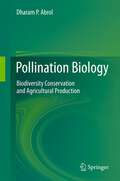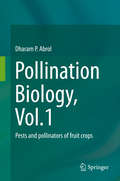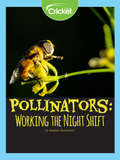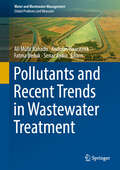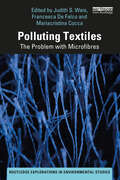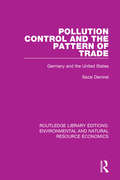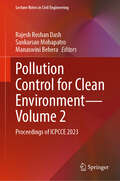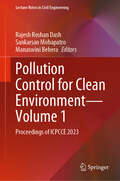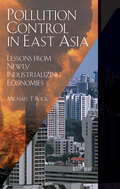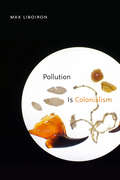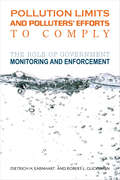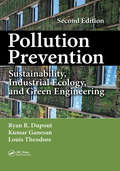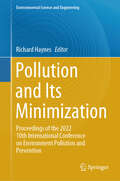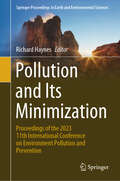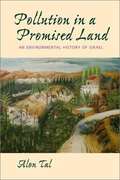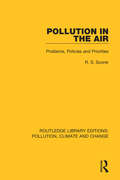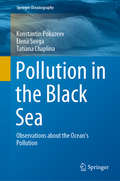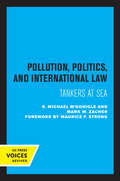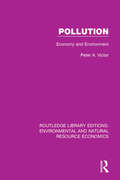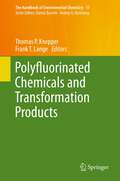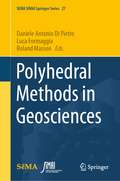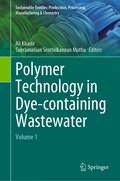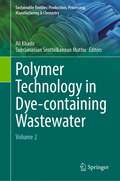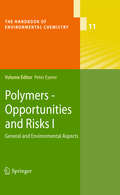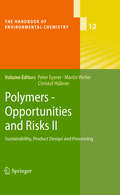- Table View
- List View
Pollination Biology
by Dharam P. AbrolThis book has a wider approach not strictly focused on crop production compared to other books that are strictly oriented towards bees, but has a generalist approach to pollination biology. It also highlights relationships between introduced and wild pollinators and consequences of such introductions on communities of wild pollinating insects. The chapters on biochemical basis of plant-pollination interaction, pollination energetics, climate change and pollinators and pollinators as bioindicators of ecosystem functioning provide a base for future insights into pollination biology. The role of honeybees and wild bees on crop pollination, value of bee pollination, planned honeybee pollination, non-bee pollinators, safety of pollinators, pollination in cages, pollination for hybrid seed production, the problem of diseases, genetically modified plants and bees, the role of bees in improving food security and livelihoods, capacity building and awareness for pollinators are also discussed.
Pollination Biology, Vol.1
by Dharam P. AbrolThe book covers interplay between pest management strategies and safety of pollinators. Detailed information is provided on pests and pollinators of temperate, subtropical and tropical fruit crops. Most of the fruit crops are highly cross pollinated and depend upon insects or benefit from insect pollination for fruit set. Insect pests on the other hand cause major economic damage on fruit crops in tropics, subtropics and temperate. Evidently, pest management in fruit crops on one hand and providing safety to the pollinators on the other is a challenging task in the context of increasing horticultural productivity without upsetting the ecological balance. This book aims to integrate and develop pest control strategies in a way to minimize their impact on beneficial insect species such as natural enemies and pollinators to enhance fruit production and quality. The book covers interplay between pest management strategies and safety of pollinators. Detailed information is provided on pests and pollinators of temperate, subtropical and tropical fruit crops. Pollinators play a crucial role in flowering plant reproduction and in the production of most fruits and vegetables. Most of the fruit crops are highly cross pollinated and depend upon insects or benefit from insect pollination for fruit set. Insect pests on the other hand cause major economic damage on fruit crops in tropics, subtropics and temperate. Evidently, pest management in fruit crops on one hand and providing safety to the pollinators on the other is a challenging task in the context of increasing horticultural productivity without upsetting the ecological balance. This book aims to integrate and develop pest control strategies in a way to minimize their impact on beneficial insect species such as natural enemies and pollinators to enhance fruit production and quality. Most of the fruit crops are highly cross pollinated and depend upon insects or benefit from insect pollination for fruit set. Insect pests on the other hand cause major economic damage on fruit crops in tropics, subtropics and temperate. Evidently, pest management in fruit crops on one hand and providing safety to the pollinators on the other is a challenging task in the context of increasing horticultural productivity without upsetting the ecological balance. This book aims to integrate and develop pest control strategies in a way to minimize their impact on beneficial insect species such as natural enemies and pollinators to enhance fruit production and quality. The book covers interplay between pest management strategies and safety of pollinators.
Pollinators: Working the Night Shift
by Stephen BuchmannBees, moths, birds, and bats are all pollinators. But what are they actually doing? Why do flowers make pollen and why do they need it? Readers will discover that without pollinators, we wouldn't have fruit or vegetables to eat, so it's up to us to protect these vital animals.
Pollutants and Recent Trends in Wastewater Treatment (Water and Wastewater Management)
by Andreas Haarstrick Ali Müfit Bahadir Fatma Beduk Senar AydinThis book demonstrates the variability and extension of environmental pollutants in water and wastewater, besides with recent technological developments in wastewater treatment. It covers review articles and research studies written in a clear style that makes it informative for scientists, researchers, professionals, and students. This book provides a comprehensive overview of the current state of knowledge regarding source, transport and fate of not only emerging compounds, but also pollutants gaining importance over time, such as pharmaceuticals, microplastics, and viruses. It ensures to understand the dimension of the adverse effects on ecosystem and human health through various exposure pathway. The book also covers recent trends in wastewater treatment, with a focus on membrane technologies allowing to remove even very small concentrations of pollutants.
Polluting Textiles: The Problem with Microfibres (Routledge Explorations in Environmental Studies)
by Judith S. Weis Mariacristina Cocca Francesca De FalcoThis book examines the critical issue of environmental pollutants produced by the textiles industry. Comprised of contributions from environmental scientists and materials and textiles scientists, this edited volume addresses the environmental impact of microplastics, with a particular focus on microfibres released by textiles into marine and water environments. The chapters in Part I offer environmental perspectives focusing on the measurement of microplastics in the environment, their ingestion by small plankton and larger filter feeders, the effects of consuming microplastics, and the role of microplastics as a vector for transferring toxic contaminants in food webs. Written by environmental and material scientists, the chapters in Part II present potential solutions to the problem of microplastics released from textiles, discussing parameters of influence, water treatment, degradation in marine environment, textile end-of-life management, textile manufacturing and laundry, possible policy measures. This is a much needed volume which brings together in one place environmental research with technical solutions in order to provide a cohesive and practical approach to mitigating and preventing environmental pollution from the textiles industry going forward. This book will be of great interest to students and scholars of environmental conservation and management, environmental pollution and environmental chemistry and toxicology, sustainability, as well as students and scholars of material and textiles science, textile engineering and sustainable manufacturing.
Pollution Control and the Pattern of Trade: Germany and the United States (Routledge Library Editions: Environmental and Natural Resource Economics)
by Sezai DemiralThis title, first published in 1990, is intended to assess the impact of national environmental control policies on international trade and competitiveness in general, and, in particular, the impact of differential environmental control policies on the international trade and competiveness of the two industrialized nations, Germany and the United States. To assess the impact of differential environmental control policies on trade, this study applies a comparative analysis of the two countries.
Pollution Control for Clean Environment — Volume 2: Proceedings of ICPCCE 2023 (Lecture Notes in Civil Engineering #416)
by Sankarsan Mohapatro Manaswini Behera Rajesh Roshan DashThis book presents select proceedings of the International Conference on Pollution Control for Clean Environment (ICPCCE-2023). It introduces readers to the recent emerging pollutants in air and water environments and in solid waste and sheds light on the newly developed control strategies. The book discusses various topics including the occurrence of emerging contaminants, micropollutants in water, wastewater and aquatic environments, occurrence pathways, surface and groundwater pollution, and risk and impact assessment of pollution. The chapters provide advanced information topics including effective monitoring, detection, sustainable practices, cleaner and innovative water and wastewater treatment technologies, and emerging contaminant removal. The book also includes information on energy-positive technologies and recent advances in the upgradation of existing systems. It also extensively discusses life cycle assessment and the application of environmental indicators and circular economy in pollution control strategies. The book covers the interaction of pollutants in the atmosphere and discusses innovative air pollution control strategies, including a detailed discussion of carbon capture and storage. The book presents various strategies for managing solid waste and discusses several novel technologies for the management of the present-day concern of plastic waste and e-waste. Given the present-day need for the recovery and re-use of various waste materials, this book delves extensively into how waste materials can be used for different purposes. It also talks about the recovery of energy and other useful by-products contributing towards economical and sustainable solutions. The book discusses various case studies on recently developed technologies and evaluates a wide range of technologies for pollutant removal and their implementation in the field. This book provides a ready reference for environmental engineers, practitioners, policymakers, and planners. It also served as a practical guide for industrial engineers, government bodies, ecologists, and researchers.
Pollution Control for Clean Environment—Volume 1: Proceedings of ICPCCE 2023 (Lecture Notes in Civil Engineering #415)
by Sankarsan Mohapatro Manaswini Behera Rajesh Roshan DashThis book presents select proceedings of the International Conference on Pollution Control for Clean Environment (ICPCCE-2023). It introduces readers to the recent emerging pollutants in air and water environments and in solid waste and sheds light on the newly developed control strategies. The book discusses various topics including the occurrence of emerging contaminants, micropollutants in water, wastewater and aquatic environments, occurrence pathways, surface and groundwater pollution and risk and impact assessment of pollution. The chapters provide advanced information topics including effective monitoring, detection, sustainable practices, cleaner and innovative water and wastewater treatment technologies, and emerging contaminant removal. The book also includes information on energy-positive technologies and recent advances in the upgradation of existing systems. It also extensively discusses life cycle assessment and the application of environmental indicators and circulareconomy in pollution control strategies. The book covers the interaction of pollutants in the atmosphere and discusses innovative air pollution control strategies, including a detailed discussion of carbon capture and storage. The book presents various strategies for managing solid waste and discusses several novel technologies for the management of the present-day concern of plastic waste and e-waste. Given the present-day need for the recovery and re-use of various waste materials, this book delves extensively into how waste materials can be used for different purposes. It also talks about the recovery of energy and other useful by-products contributing towards economical and sustainable solutions. The book discusses various case studies on recently developed technologies and evaluates a wide range of technologies for pollutant removal and their implementation in the field.This book provides a ready reference for environmental engineers, practitioners, policymakers and planners. It also served as a practical guide for industrial engineers, government bodies, ecologists and researchers.
Pollution Control in East Asia: Lessons from Newly Industrializing Economies (Environmental Development Ser. #No. 9)
by Michael T. RockWhy do some economies seem to excel at effective pollution management while others miss the mark when responding to deteriorating urban environments? These studies of pollution management in East Asia's newly industrialized economies (NIEs) include successful government responses in Singapore and Taiwan, qualified results in China and Indonesia, and much more limited success in Thailand and Malaysia. In each example, Michael Rock considers the starting point of the economy as it began its path toward industrialization in the post World War II period. He discusses the relevant historical and political context, the pressures placed on the political system from domestic and international sources, and the influence of ongoing trends in East Asia for democratization and economic liberalization. Rock's text makes it clear that each economy found unique, innovative ways to link environmental protection to its own political and economic institutions. Thus, while public pressure from both home and abroad gave strong impetus to successful programs in Taiwan, the development of policy in Singapore involved limited public review and a centralized, government-led process. The result of Rock's scholarship is a book that provides important lessons without being reductionist. The book offers insights to apply to pollution management in a diverse range of developing nations, but avoids attempts for precise prescriptions, or universally appealing, normative answers. A copublication of Resources for the Future and the Institute of Southeast Asian Studies (ISEAS).
Pollution Is Colonialism
by Max LiboironIn Pollution Is Colonialism Max Liboiron presents a framework for understanding scientific research methods as practices that can align with or against colonialism. They point out that even when researchers are working toward benevolent goals, environmental science and activism are often premised on a colonial worldview and access to land. Focusing on plastic pollution, the book models an anticolonial scientific practice aligned with Indigenous, particularly Métis, concepts of land, ethics, and relations. Liboiron draws on their work in the Civic Laboratory for Environmental Action Research (CLEAR)—an anticolonial science laboratory in Newfoundland, Canada—to illuminate how pollution is not a symptom of capitalism but a violent enactment of colonial land relations that claim access to Indigenous land. Liboiron's creative, lively, and passionate text refuses theories of pollution that make Indigenous land available for settler and colonial goals. In this way, their methodology demonstrates that anticolonial science is not only possible but is currently being practiced in ways that enact more ethical modes of being in the world.
Pollution Limits and Polluters’ Efforts to Comply: The Role of Government Monitoring and Enforcement
by Dietrich H. Earnhart Robert L. GlicksmanThis book integrates the fields of economics and law to empirically examine compliance with regulatory obligations under the Clean Water Act (CWA). It examines four dimensions of federal water pollution control policy in the United States: limits imposed on industrial facilities' pollution discharges; facilities' efforts to comply with pollution limits, identified as "environmental behavior"; facilities' success at controlling their discharges to comply with pollution limits, identified as "environmental performance"; and regulators' efforts to induce compliance via inspections and enforcement actions, identified as "government interventions." The authors gather and analyze data on environmental performance and government interventions from Environmental Protection Agency (EPA) databases, and data on environmental behavior gathered from their own survey of all 1,612 chemical manufacturing facilities permitted to discharge wastewater in 2002. By analyzing links between critical elements in the puzzle of enforcement of and compliance with environmental protection laws, the text speaks to several important, policy-relevant research questions: Do government interventions help induce better environmental behavior and/or better environmental performance? Do tighter pollution limits improve environmental behavior and/or performance? And, does better environmental behavior lead to better environmental performance?
Pollution Prevention: Sustainability, Industrial Ecology, and Green Engineering, Second Edition
by Louis Theodore Kumar Ganesan Ryan DupontThis new edition has been revised throughout, and adds several sections, including: lean manufacturing and design for the environment, low impact development and green infrastructure, green science and engineering, and sustainability. It presents strategies to reduce waste from the source of materials development through to recycling, and examines the basic concepts of the physical, chemical, and biological properties of different pollutants. It includes case studies from several industries, such as pharmaceuticals, pesticides, metals, electronics, petrochemicals, refineries, and more. It also addresses the economic considerations for each pollution prevention approach.
Pollution and Its Minimization: Proceedings of the 2022 10th International Conference on Environment Pollution and Prevention (Environmental Science and Engineering)
by Richard HaynesThis book presents peer-reviewed papers of the 2022 10th International Conference on Environment Pollution and Prevention (ICEPP 2022), which was held in Sydney, Australia, during December 16–18, 2022. With the worldwide increase in industrialization and movement of people toward larger cities, there has been a progressive increase in environmental pollution. The issues surrounding air, water, soil, and land pollution are now considered of global concern. Minimization of pollution involves the repeated reuse of products, reduction in waste generation, and processing and recycling of resources into new products. Pollution prevention practices not only reduce waste, but also improve safety and decrease disposal costs. The book is useful for students, academics, entrepreneurs, and professionals who are working in the important field of environmental pollution and its prevention.
Pollution and Its Minimization: Proceedings of the 2023 11th International Conference on Environment Pollution and Prevention (Springer Proceedings in Earth and Environmental Sciences)
by Richard HaynesThis book is a collection of selected, peer-reviewed papers presented at the 2023 11th International Conference on Environment Pollution and Prevention (ICEPP 2023), which was held in Brisbane, Australia, November 10–12, 2023. With the worldwide increase in industrialization and movement of people towards larger cities, there has been a progressive increase in pollution of the environment. The issues surrounding air, water, soil and land pollution are now considered of global concern. Minimization of pollution involves the repeated reuse of products, reduction in waste generation and processing and recycling of resources into new products. Pollution prevention practices not only reduce waste, but also improve safety and decrease disposal costs. The book is useful for students, academics, entrepreneurs and professionals who are working in the important field of pollution of the environment and its minimization and prevention.
Pollution in a Promised Land: An Environmental History of Israel
by Alon TalVirtually undeveloped one hundred years ago, Israel, the promised "land of milk and honey," is in ecological disarray. In this gripping book, Alon Tal provides--for the first time ever--a history of environmentalism in Israel, interviewing hundreds of experts and activists who have made it their mission to keep the country's remarkable development sustainable amid a century of political and cultural turmoil. The modern Zionist vision began as a quest to redeem a land that bore the cumulative effects of two thousand years of foreign domination and neglect. Since then, Israel has suffered from its success. A tenfold increase in population and standard of living has polluted the air. The deserts have bloomed but groundwater has become contaminated. Urban sprawl threatens to pave over much of the country's breathtaking landscape. Yet there is hope. Tal's account considers the ecological and tactical lessons that emerge from dozens of cases of environmental mishaps, from habitat loss to river reclamation. Pollution in a Promised Land argues that the priorities and strategies of Israeli environmental advocates must address issues beyond traditional green agendas.
Pollution in the Air: Problems, Policies and Priorities
by R. S. ScorerOriginally published in 1973, this book has enduring relevance in the 21st Century. Asking difficult questions it encourages the reader to think about the individual and societal changes which are needed to protect the planet and the health and prosperity of future generations. Despite the title of the book, it covers air, water and land pollution, evolution, the industrial revolution, the growth of technology, climatology and meteorology, pollution legislation and the economics of a green economy.
Pollution in the Black Sea: Observations about the Ocean's Pollution (Springer Oceanography)
by Konstantin Pokazeev Tatiana Chaplina Elena SovgaThis book provides information on the causes, consequences, and possible solutions to modern environmental problems associated with ocean pollution with a particular focus on the Back Sea. The oceans are a vast but fragile complex. In recent decades, it has become especially manifest when ocean pollution has reached an unparalleled situation. Meanwhile, not only the well-being of ecosystems depends on the state of ocean waters, but human civilization largely depends on the oceans as a consequence of environmental dependence. This book examines the consequences of pollutants such as oil and hydrocarbon products (including plastics and microplastics), water acidification, sewage, wastewaters discharge into the ocean, thermal pollution, nuclear pollution, and biological pollution. Beyond the types of pollutants and their consequences, this book outlines the state of the art of the legal situation internationally regarding ocean pollution. The authors also show the current pollution of the inland seas, taking as an example of the Black Sea (anthropogenic and natural sources of pollution, its shelf, and shallow waters as well as international legislation). A part of the book analyzes the main types of environmental monitoring of the oceans and their role in solving ocean pollution problems with a particular interest in the Black Sea. The book is of interest to specialists in ocean pollution, ecologists, oceanologists, students, and graduate students studying oceanography, marine ecology, current methods of environmental monitoring, and legal problems related to the oceans and seas pollution, as well as to anyone interested in modern problems of the oceans.
Pollution, Politics, and International Law: Tankers at Sea
by R. Michael M’Gonigle Mark W. ZacherThis title is part of UC Press's Voices Revived program, which commemorates University of California Press’s mission to seek out and cultivate the brightest minds and give them voice, reach, and impact. Drawing on a backlist dating to 1893, Voices Revived makes high-quality, peer-reviewed scholarship accessible once again using print-on-demand technology. This title was originally published in 1979.
Pollution: Economy and Environment (Routledge Library Editions: Environmental and Natural Resource Economics)
by Peter A. VictorThis study, originally published in 1972, examines the connections between human society and the rest of the universe that are attributable to economic activity. These include the inputs from the environment to industry, such as oxygen, used in the combustion of mineral fuels. Also included are the industrial outputs which are fed back into the environment in the form of waste products. An attempt will be made to establish functional relations between the extent and character of economic activity and the flow of materials in both directions between the economy and the environment. This title will be of interest to students of environmental and natural resource economics.
Polyfluorinated Chemicals and Transformation Products
by Thomas P. Knepper Frank T. LangeDue to their unparalleled effectiveness and efficiency, polyfluorinated chemicals (PFC) have become essential in numerous technical applications. However, many PFCs brought to market show limited biodegradability, and their environmental persistence combined with toxic and bioaccumulative potential have become a matter of concern in some instances. This volume highlights the synthesis of PFCs, focusing on substances with improved application and environmental properties, which are a challenge for synthetic chemists. Further, modern mass spectrometric techniques for the detection and identification of biotransformation products of PFCs are described. The sorption and leaching behavior of PFC in soil is also addressed in order to predict their fate in the environment. Several contributions discuss the monitoring of PFCs in European surface, ground and drinking waters, treatment options for PFC removal from drinking water, occurrence in food, and the human biomonitoring of PFCs.
Polyhedral Methods in Geosciences (SEMA SIMAI Springer Series #27)
by Luca Formaggia Daniele Antonio Di Pietro Roland MassonThe last few years have witnessed a surge in the development and usage of discretization methods supporting general meshes in geoscience applications. The need for general polyhedral meshes in this context can arise in several situations, including the modelling of petroleum reservoirs and basins, CO2 and nuclear storage sites, etc. In the above and other situations, classical discretization methods are either not viable or require ad hoc modifications that add to the implementation complexity. Discretization methods able to operate on polyhedral meshes and possibly delivering arbitrary-order approximations constitute in this context a veritable technological jump. The goal of this monograph is to establish a state-of-the-art reference on polyhedral methods for geoscience applications by gathering contributions from top-level research groups working on this topic. This book is addressed to graduate students and researchers wishing to deepen their knowledge of advanced numerical methods with a focus on geoscience applications, as well as practitioners of the field.
Polymer Technology in Dye-containing Wastewater: Volume 1 (Sustainable Textiles: Production, Processing, Manufacturing & Chemistry)
by Subramanian Senthilkannan Muthu Ali KhadirDyes are versatile compounds that have been successfully used in textile printing, rubber, cosmetics, plastic, pharmaceutical, and leather industries to color the products. Dye-using industries, particularly textile or printing industries are responsible for the generation of a great amount of colored wastewater that are polluting and threatening the environment. Many of these dyes are carcinogenic, mutagenic, and teratogenic, as well as harmful to human, aquatic life, and other living things and their elimination from wastewater is highly essential. Various approaches have been implemented in the efforts to mitigate the issue related to textile wastewater, such as adsorption, biological processes, advanced oxidation processes, membrane technology, etc. In this Volume 1, the application of various types of polymers in different wastewater treatment technologies are presented. The synthesis procedure of some polymers, the polymer modification, the effect of operational parameters on polymer efficiency, the interactions between polymers – dyes, etc are discussed.
Polymer Technology in Dye-containing Wastewater: Volume 2 (Sustainable Textiles: Production, Processing, Manufacturing & Chemistry)
by Subramanian Senthilkannan Muthu Ali KhadirThe textile industry is among the most significant polluters of water owing to the existence of various types of pollution streams generated by printing processes and textile dyeing. The book begins by documenting various types of Poly (vinyl alcohol) PVA-derived adsorbents (gels, fibers, films, composite particles), membranes, and photocatalysts in combination with conventional adsorbents, polymers, carbonaceous and metallic materials and their use in elimination of dyes from contaminated water. It follows by discussing different properties of nanocomposite membranes such as hydrogels, xerogels and aerogels used in this purpose. Also, different polymer – based adsorbents such as ceramic adsorbent, clay, hydrogels, starch, cellulose, chitosan, alginates, etc are presented in this book.
Polymers - Opportunities and Risks I
by Peter EyererSince their first industrial use polymers have gained a tremendous success. The two volumes of "Polymers - Opportunities and Risks" elaborate on both their potentials and on the impact on the environment arising from their production and applications. Volume 11 "Polymers - Opportunities and Risks I: General and Environmental Aspects" is dedicated to the basics of the engineering of polymers - always with a view to possible environmental implications. Topics include: materials, processing, designing, surfaces, the utilization phase, recycling, and depositing. Volume 12 "Polymers - Opportunities and Risks II: Sustainability, Product Design and Processing" highlights raw materials and renewable polymers, sustainability, additives for manufacture and processing, melt modification, biodegradation, adhesive technologies, and solar applications. All contributions were written by leading experts with substantial practical experience in their fields. They are an invaluable source of information not only for scientists, but also for environmental managers and decision makers.
Polymers - Opportunities and Risks II
by Peter Eyerer Christof Hübner Martin WellerSince their first industrial use polymers have gained a tremendous success. The two volumes of "Polymers - Opportunities and Risks" elaborate on both their potentials and on the impact on the environment arising from their production and applications. Volume 11 "Polymers - Opportunities and Risks I: General and Environmental Aspects" is dedicated to the basics of the engineering of polymers - always with a view to possible environmental implications. Topics include: materials, processing, designing, surfaces, the utilization phase, recycling, and depositing. Volume 12 "Polymers - Opportunities and Risks II: Sustainability, Product Design and Processing" highlights raw materials and renewable polymers, sustainability, additives for manufacture and processing, melt modification, biodegradation, adhesive technologies, and solar applications. All contributions were written by leading experts with substantial practical experience in their fields. They are an invaluable source of information not only for scientists, but also for environmental managers and decision makers.
